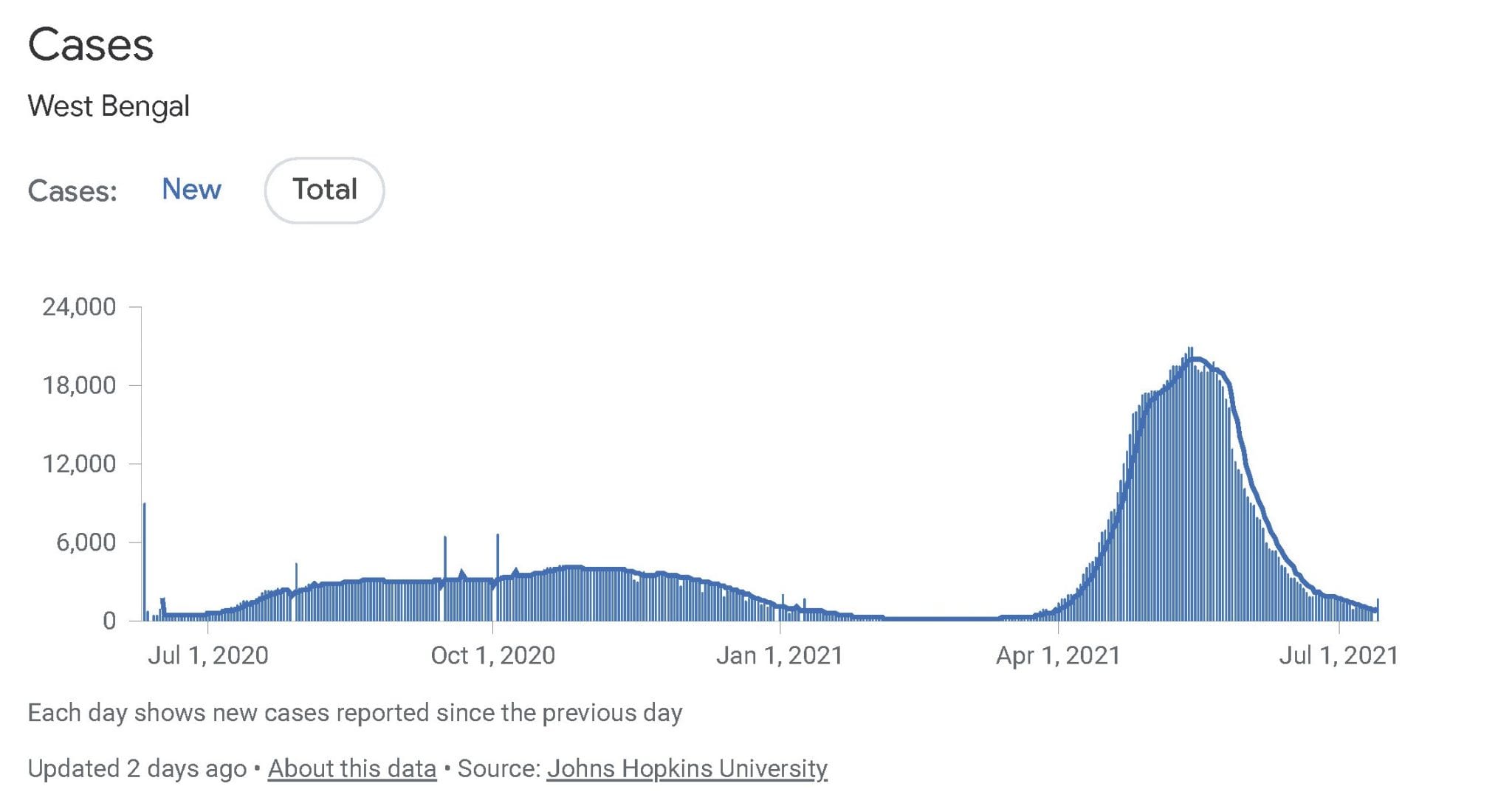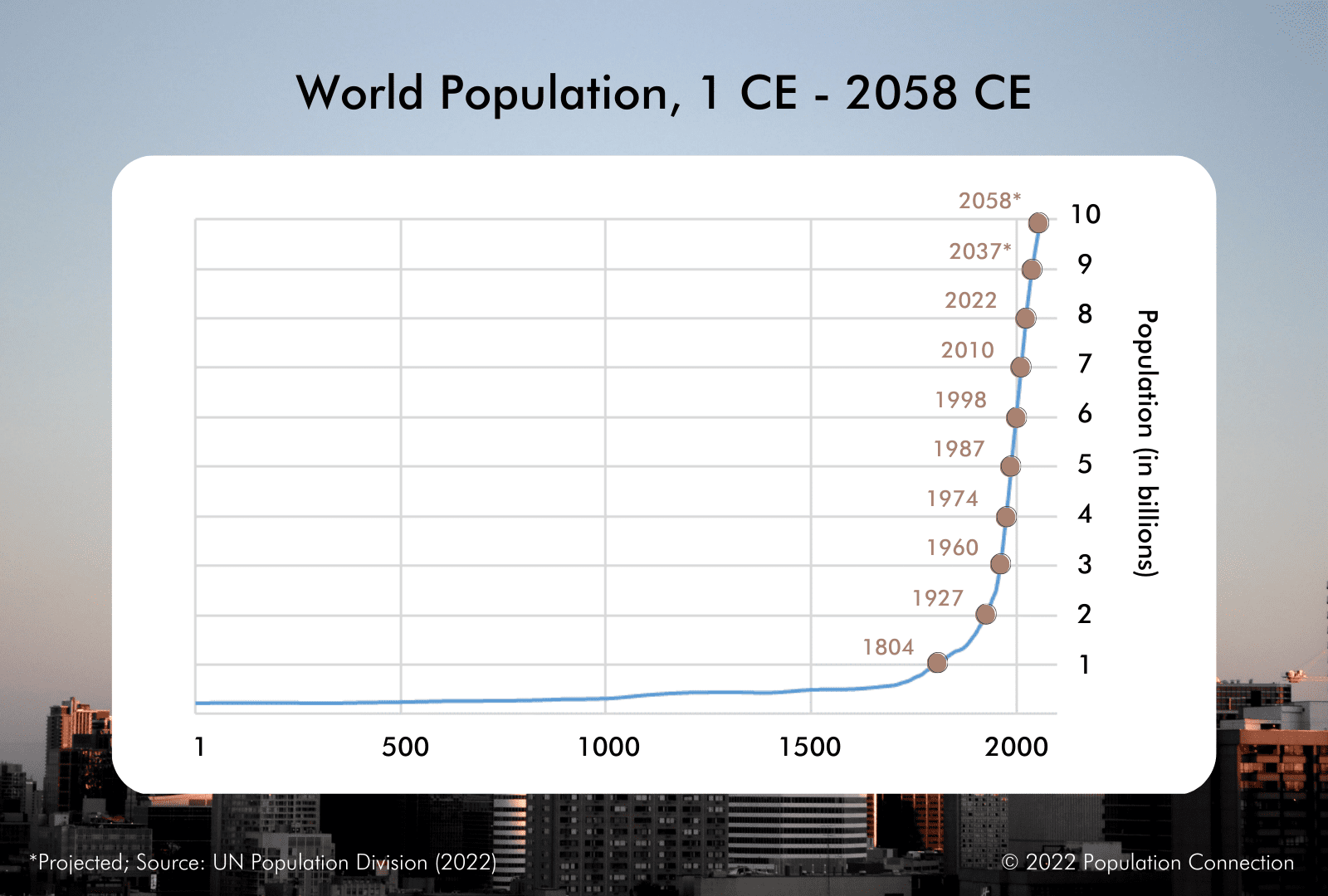Exponential growth fuels many phenomena around the world. From population to wildfires to the expansion of agricultural land, this explosive growth pattern creates challenges for our global society now and in the future. Understanding exponential growth isn’t just key to understanding the world’s problems, but solving them as well.
Understanding Exponential Population Growth, or the “J-Curve”
Human population growth is one of the most famous examples of exponential growth because of its archetypical curve. We often refer to the graph of human population growth as a “J-curve” because of the letter that so closely resembles its shape. The gradual increase in slope suddenly gives way to a sharp increase that looks nearly vertical at first glance, and a J-curve is born.
More than just a letter, this graph shape represents exponential growth, or a growth pattern where the growth of a population proportionately increases the rate of expansion as well. In other words, as a population grows larger, it will start to grow more quickly as well.
Exponential Disease Transmission and COVID-19
The spread of COVID-19 is a spectacle of exponential disease transmission that the world has seen develop right in front of us. When news outlets reported in the fall of 2019 on a strange new disease seen in Wuhan, nobody would have predicted that it would transform into a global pandemic and take millions of lives. Unfortunately, COVID-19’s rapid spread is in some ways predictable, as it has followed the path to exponential growth that many diseases have followed previously.
Luckily, graphs of global COVID-19 cases hardly look like the J-curve seen with human population. When experts spoke of “flattening the curve,” the curve in question was that of exponential growth. Staying home, wearing masks, and socially distancing are all methods to stop cases from exploding into an exponential growth pattern. Instead, the number of global COVID-19 cases swells and dips in response to factors both mitigating and spurring the spread of disease.
 However, the exponential growth pattern is alarmingly present on more local levels. May 2021 was a challenging month for India, where a number of factors including slow vaccine distribution and an overtaxed healthcare system led to a massive spike in COVID-19 cases. In Kolkata, a major hub in northeastern India, the graph of COVID-19 cases strongly resembles the J-curve, with nearly 4,000 daily cases just a few months after averaging close to zero.
However, the exponential growth pattern is alarmingly present on more local levels. May 2021 was a challenging month for India, where a number of factors including slow vaccine distribution and an overtaxed healthcare system led to a massive spike in COVID-19 cases. In Kolkata, a major hub in northeastern India, the graph of COVID-19 cases strongly resembles the J-curve, with nearly 4,000 daily cases just a few months after averaging close to zero.
While the threat of COVID-19 in India has certainly not abated, the number of daily cases has begun to fall. In fact, this graph of Kolkata shows the beginnings of the counterpart to exponential growth: exponential decay. The principle of more cases meaning faster growth has an inverse: fewer cases accelerates the rate at which cases decline as well.
Climate Change Makes Wildfires Exponentially Worse
Whether started by a single lightning strike or an errant “gender reveal” party, wildfires can become unmanageable very quickly after that initial spark. Like so many other natural processes, wildfires grow at an exponential rate, with each burning acre spreading fire to its neighbors which in turn do the same. For instance, the 2017 Eagle Creek fire in the Pacific Northwest took less than 24 hours to grow from the spark of a lit firework to a blaze covering over 3,000 acres. Firefighters often find themselves in the unenviable position of trying to extinguish fires that spread faster than they can be managed.
Unfortunately, the prevalence of wildfires is growing nearly as quickly as the fires themselves. As fire-prone areas in places like the American West and Australia face rising global temperatures and more severe droughts, the landscapes become drier and drier, transforming brush into kindling for spreading fires. Shrinking wet seasons cannot produce enough moisture to protect against scorching summers.
The volatility of these regions is already on display. The last ten years have seen some of the most destructive wildfires in global history, including the 2019-2020 Australian bushfire and California’s August Complex fire, notable for burning over a million acres in the world’s first “gigafire.” Each degree of increase in the world’s temperature exponentially expands the likelihood of wildfire.
Understanding the ways fire grow is a critical aspect of fire containment. In combination with forest management practices and advanced methods of fire suppression, this knowledge is already shaping how people respond to the rising threat of wildfires. As California alone has seen its annual acres of burned land expand by over 500% since the 1970s, these practices will remain critical to avoiding wide-scale wildfire destruction.
Looking to an Exponential Future
Exponential growth patterns are evident in countless ways, both natural and anthropogenic. While the growth of human population is expected to level out by the end of this century, many other global challenges contain the potential to exponentially grow for much longer. Whatever the future holds, understanding this fundamental mathematical principle is one part of a robust understanding of people, the planet, and the world we share together.
Image credit: West Bengal graph (Data from: “Dong E, Du H, Gardner L. An interactive web-based dashboard to track COVID-19 in real time. Lancet Inf Dis. 20(5):533-534. doi: 10.1016/S1473-3099(20)30120-1; Graph from: Google News (2021). West Bengal Coronavirus (COVID-19). Google News: https://news.google.com/covid19/map?hl=en-US&gl=US&ceid=US%3Aen&mid=%2Fm%2F086g2. Accessed July 14, 2021.)





